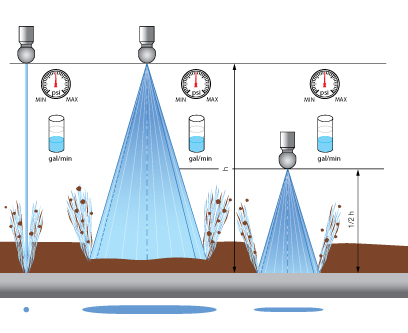Planning Guide for Proper Tank Cleaning

Planning a way to properly and efficiently clean your tank isn't always a easy task. Selecting the right tank cleaning nozzle, what pressure is best, and where should I postion the tank nozzle are just some of the important factors to consider when planning the perfect tank cleaning application. We understand there is a lot that goes into planning your tank cleaning application which is why we have created a simple guide to help you.
Basic Nozzle Operating Principles
Static and Rotational

Static - spray balls deliver a solid stream of spray and do not provide full coverage for cleaning. Rotating nozzles, on the other hand, spray the entire surface of the tank and provide more penetration for removing stubborn soils. There are three different types of rotational spray nozzles:

Free spinning - This cleaning device is driven by the pressure of the water. The head of the nozzle rotates faster as the pressure increases. These nozzles clean best at low pressures of 40 to 60 psi and are perfect for small to medium size tanks.

Controlled rotation – The rotation of this nozzle is controlled by an internal turbine and it contains no gears. The slower rotation provides more impact and better spray coverage for removing very difficult soils. These nozzles can also be run at higher pressures, which will not affect the speed of the rotation.

Gear-controlled – These types of nozzles provide the highest impact and are excellent for cleaning large tanks. The nozzle rotates on two axis points, which allows it to sweep the entire circumference of the tank interior. This assures every spot will be cleaned.
Mechanical cleaning effects
The first step is selecting the proper nozzle for your application. If your application requires a simple rinse, a static nozzle will most likely work and no mechanical action is required. However, if your soil is more aggressive, mechanical cleaning is required. Mechanical cleaning delivers the greatest impact when cleaning the surface area of the tank and rotating nozzles provide this effect. Large droplets will strike at high speeds, which enable thick soils to be removed because they cannot be dissolved by the cleaning fluid alone.
Impact, Flow rate and Pressure
IMPACT
The impact surface is the area where the droplet strikes. The smaller the surface area, the greater the impact values. Nozzles with high impact are for for example, solid stream nozzles and flat fan nozzles with a narrow spray angle.

FLOW RATE
Increasing the flow rate by using a larger nozzle increases the impact, assuming that the other parameters (spray angle, pressure and medium) remain the same.
PRESSURE
In contrast to static cleaning nozzles, there is no linear relationship between pressure and impact for rotating nozzles. With rotating nozzles, the supply pressure normally influences the rotation speed. The higher the rotation speed, the greater the tendency of rotating nozzles to atomize the fluid into much smaller droplets. This effect has a negative influence on impact. Lechler rotating cleaning nozzles should therefore be used at the recommended operating pressure range.

Influence of chemistry and temperature
Chemicals, time and temperature all cost money, so by using less you will save more money in the long run. Choosing the correct nozzle for your cleaning process, will have a positive effect on all 3 of these. The right temperature and chemicals being used with the correct nozzle will help reduce your cleaning cycle, which means less chemicals and downtime. Not only does this save you money but now you can produce more product.
Additional factors to consider

Tank Clean Simulation Software
We utilize a tank cleaning simulation software which allows you plan your tank cleaning. To do this, we replicate the tank geometry in the software and then simulate the spraying operation. Operation of all Lechler tank cleaning nozzles can be simulated – from the static spray ball to the high-impact tank cleaning machine. The result of the simulation is documented and provided in a PDF or video file. Simulation with TankClean can already be used as the basis for optimum cleaning in the planning phase of new tanks, but is also suitable for optimizing existing tank cleaning processes.
Suggested Literature
Tank and Equipment Cleaning BrochureLechler's experts are here to help you with every step of the process.